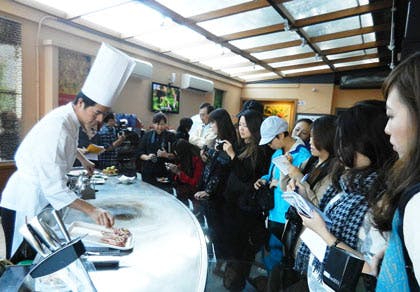Premium U.S. Pork Promotion Makes Waves in Taiwan

Chef Chen’s demonstration was well-attended by Taiwan media
The people of Taiwan love home-grown pork, but high-quality American pork is becoming the media darling in this meat-loving island nation of 23 million.
U.S. pork typically goes into processing in Taiwan, but a crowd of gourmet bloggers and reporters from newspapers, television and magazines showed that Taiwanese are hungry for news about premium consumer-ready U.S. pork by covering a USMEF event produced with support from the Pork Checkoff.
Celebrity chef Chen of ShenYen Teppenyaki entertained the assembled reporters while serving samples of French-cut bone-in loin, Boston butt and spareribs combined with local ingredients in six delicious dishes. Interviews with the chef discussing the attributes of U.S. pork and his distinctive recipes were carried in the many media outlets attending including the China Post, Taiwan News, China Times, Commercial Times and SET-TV.
“Using high-quality ingredients is a delightful experience,” said Chef Chen. “You know that they are special and different from other ingredients.”
The goal of the promotion was to help U.S. pork gain a larger share of the food service sector by capitalizing on demand for branded, premium pork dishes at high-end restaurants and hotels.

U.S. pork is highly visible on this commuter bus
“The finest hotels and restaurants want to distinguish themselves from their competition by serving distinctive dishes such as dry-aged pork steaks and branded pork,” said Davis Wu, USMEF-Taiwan director. “Raising the awareness of high-quality U.S. pork with this audience is a good step toward building consumer demand.”
The event with Chef Chen was one part of a broader campaign that includes retail promotions and a distinctive rolling U.S. pork billboard – images of healthy young piglets wrapping a bus that commutes hourly through the capital Taipei and neighboring Ilan County.
While efforts to promote U.S. pork to processors are challenged by Taiwan’s zero tolerance for growth promotant residues, USMEF is encouraged by the positive reception to its market development program for U.S. chilled and processed pork.
“Many consumers are unaware of the quality of U.S. pork and where it can be purchased.” said Wu. “Seeing Chef Chen demonstrate easy-to-cook pork recipes while discussing the positive attributes of U.S. pork for high-end foodservice sends a strong message to those chefs searching for unique food ingredients.

U.S. pork also was a hit on Taiwan television
“Developing consumer-oriented activities for the Taiwan market enables us to better control the messages and communicate directly to the end consumer,” added Wu. “That helps create a new atmosphere for U.S. pork and elevate it to a higher-quality status.”
While Taiwan is 94 percent self-sufficient in pork, consumers here enjoy significantly more red meat than their Japanese and South Korean counterparts and slightly more than mainland China, and pork is by far the local favorite.
Despite the growth promotant residue issue, USMEF has made inroads in expanding the market for U.S. pork beyond the processing sector, including at the retail level, with growth supported by a younger generation that shops more in supermarkets and hypermarkets than traditional wet markets. There are growing opportunities for U.S. pork niche items such as natural pork and unique processed and branded items.
Through October, Taiwan has purchased 16,553 metric tons (36.5 million pounds) of U.S. pork valued at $36.4 million, increases of 10 percent and 6 percent respectively over last year.
